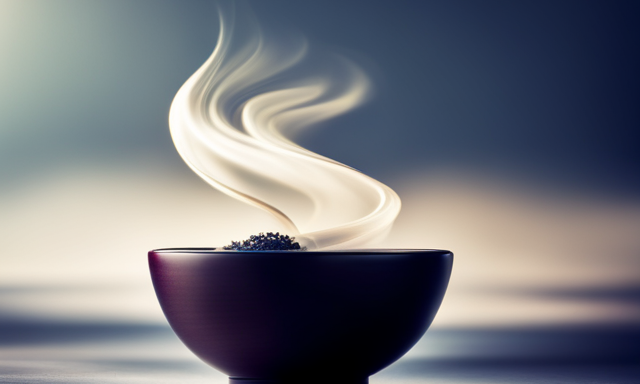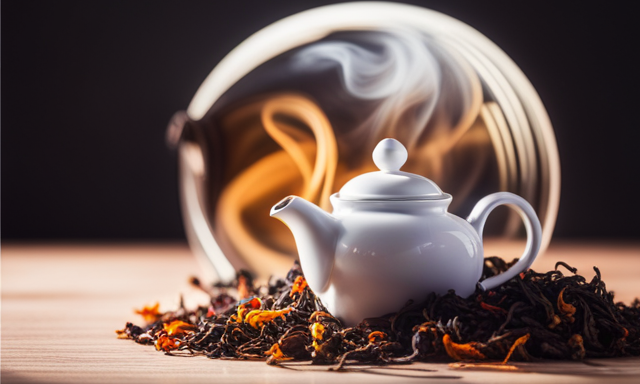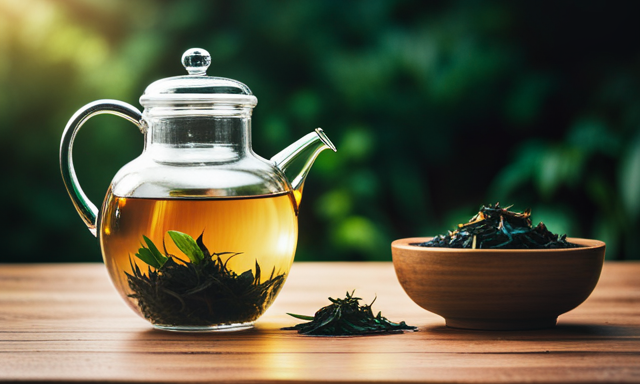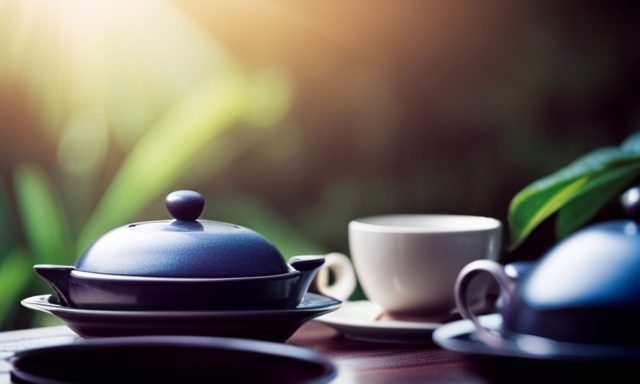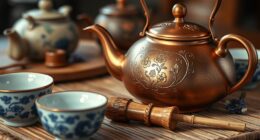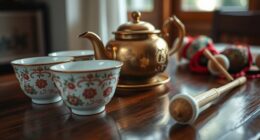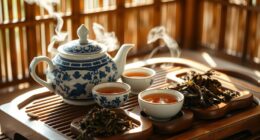Did you know that oolong tea is one of the most fascinating and sought-after teas in the world? With its rich flavor profile and unique processing methods, oolong tea has captured the attention of tea enthusiasts worldwide.
But what exactly is oolong tea in terms of its energetic properties, specifically its yin and yang nature?
In this article, I will delve into the origins and history of oolong tea, and explore the concept of yin and yang in traditional Chinese medicine. We will also take a closer look at the flavor profile of oolong tea and the various processing methods that give it its distinctive character. And of course, we’ll tackle the age-old debate: is oolong tea yin or yang?
Furthermore, I will discuss the numerous health benefits of oolong tea and provide tips on how to brew and enjoy this delightful beverage. Finally, we will delve into the cultural significance of oolong tea, showcasing its importance in various societies around the world.
So, grab a cup of oolong tea and join me on this journey of exploration and discovery. Let’s uncover the secrets of this remarkable tea and unravel the mystery of its yin and yang nature.
Key Takeaways
- Oolong tea is believed to possess both yin and yang qualities.
- It has a cooling and calming effect on the body, but also provides a warming and invigorating sensation.
- Oolong tea offers a diverse range of flavors, from floral to nutty.
- It is both energizing and calming, promoting focus, mental clarity, and relaxation.
The Origins and History of Oolong Tea
Oolong tea has a fascinating history and its origins can be traced back to ancient China. The word ‘oolong’ translates to ‘black dragon’ in Chinese, which is an apt description for this unique type of tea.
Oolong tea is made from the leaves of the Camellia sinensis plant, just like black tea and green tea. However, what sets oolong tea apart is its unique processing method. The leaves are partially oxidized, which gives oolong tea a flavor profile that falls somewhere between black tea and green tea.
Oolong tea cultivation requires specific environmental conditions, including high altitude and a cool climate. The leaves are carefully harvested and then undergo a meticulous process of withering, rolling, and oxidation.
Understanding the origins and cultivation of oolong tea is crucial in comprehending the yin and yang concept in traditional Chinese medicine, which will be explored in the next section.
Understanding the Yin and Yang Concept in Traditional Chinese Medicine
To understand the Yin and Yang concept in Traditional Chinese Medicine, you need to grasp the delicate balance between opposing forces.
In this philosophy, the universe is composed of dualistic energies that complement and interact with each other. The notion of yin and yang balance is deeply rooted in traditional Chinese medicine, where it’s believed that health depends on maintaining harmony between these opposing energies.
When it comes to oolong tea, the concept of energy is also important. Oolong tea is believed to possess both yin and yang qualities, making it a versatile and balanced beverage. It has a cooling and calming effect on the body, while also providing a warming and invigorating sensation. This harmonious blend of energies contributes to the overall well-being that oolong tea promotes.
Now, let’s delve into exploring the flavor profile of oolong tea.
Exploring the Flavor Profile of Oolong Tea
Immerse yourself in the world of oolong tea as you discover the intricate and captivating flavors that dance upon your taste buds. Oolong tea is renowned for its diverse flavor profiles, ranging from floral and fruity to nutty and roasted.
This unique range of flavors is a result of the partial oxidation and fermentation process that oolong tea undergoes. Each flavor profile is carefully crafted by skilled tea artisans, who control the oxidation levels to achieve the desired taste.
Not only does oolong tea offer a delightful sensory experience, but it also boasts numerous health benefits. Rich in antioxidants, oolong tea can aid in weight management, improve digestion, and boost the immune system.
With its complex flavors and extensive health benefits, oolong tea is truly a remarkable beverage.
Now, let’s delve into the processing methods of oolong tea.
The Processing Methods of Oolong Tea
With a delicate balance of fire and water, the processing methods of this enchanting brew transform its leaves into a symphony of flavors. Oolong tea undergoes a unique and intricate process that showcases its versatility and complexity.
Here are three key steps in the processing of oolong tea:
-
Partial Oxidation: Oolong tea lies between green and black teas in terms of oxidation. The leaves are withered under the sun, then shaken in bamboo baskets to bruise the edges. This allows a controlled level of oxidation to occur, resulting in a range of flavors, from floral and fruity to toasty and nutty.
-
Rolling: After the oxidation process, the leaves are rolled to shape them into tight, twisted balls. This step helps to release the tea’s natural oils and enzymes, enhancing its aromatic qualities.
-
Roasting: To further develop its unique characteristics, the rolled leaves are roasted over charcoal or in special ovens. This step adds depth and complexity to the flavor profile, creating a rich, toasty taste.
Through careful processing, oolong tea achieves a perfect harmony of flavors and aromas. Transitioning into the subsequent section about the energetic properties of oolong tea, its meticulous journey from leaf to cup sets the stage for an exploration of its captivating essence.
The Energetic Properties of Oolong Tea
Experience the invigorating and harmonizing effects of oolong tea as it enlivens your senses and uplifts your spirit. Oolong tea possesses unique energetic properties that stem from its carefully crafted processing methods.
The leaves of this tea are partially oxidized, giving it a flavor profile that falls somewhere between green and black tea. This delicate balance of oxidation results in a tea that is both energizing and calming. Oolong tea offers a gentle boost of energy, promoting focus and mental clarity, while also soothing the body and providing a sense of relaxation.
Its complex combination of compounds, including caffeine, theanine, and antioxidants, contribute to its overall energetic properties.
Transitioning into the debate about whether oolong tea is yin or yang, let’s explore the traditional perspectives on this intriguing topic.
The Debate: Is Oolong Tea Yin or Yang?
Step into the world of oolong tea and uncover the centuries-old debate of whether this enchanting beverage embodies the essence of yin or yang. Is oolong tea yin or yang? This question has sparked much discussion and holds implications in traditional Chinese medicine.
Some argue that oolong tea leans more towards the yang side, with its energizing and uplifting effects on the body. Others believe it has more yin properties, promoting relaxation and tranquility. To understand this debate, we must explore the flavor profile and processing methods of oolong tea.
With its wide range of flavors, from floral and fruity to toasty and earthy, oolong tea offers a complex taste experience. Its unique processing, which involves withering, rolling, oxidation, and firing, contributes to its distinctive flavor and potential energetic properties.
As we delve deeper into the health benefits of oolong tea, we will see how these qualities contribute to its overall impact on well-being.
The Health Benefits of Oolong Tea
Indulging in a cup of this captivating brew transports you to a world filled with vitality and harmony. Oolong tea, with its unique combination of oxidation levels, offers a plethora of health benefits. One of the most notable advantages is its potential in aiding weight loss. Studies have shown that oolong tea can boost metabolism and increase fat burning, making it a valuable addition to any weight loss regimen. Additionally, oolong tea is rich in antioxidants, which can help promote skin health by fighting off free radicals and reducing inflammation. To illustrate the various benefits of oolong tea, refer to the table below:
| Benefits of Oolong Tea |
|---|
| Aids in weight loss |
| Promotes skin health |
| Boosts metabolism |
| Increases fat burning |
| Rich in antioxidants |
Transitioning into the subsequent section about ‘how to brew and enjoy oolong tea’, let’s explore the artistry and techniques behind creating the perfect cup.
How to Brew and Enjoy Oolong Tea
Discover the enchantment of unlocking the full flavor and aroma of this captivating brew as you learn the art of brewing and savoring oolong tea.
To truly appreciate the complexity of oolong tea, it’s essential to master the proper brewing techniques. Begin by using high-quality loose leaves and filtered water to ensure the best taste. The water temperature and steeping time can vary depending on the type of oolong tea, so it’s important to follow specific guidelines.
Some popular oolong tea varieties include Tie Guan Yin, Da Hong Pao, and Dong Ding. Each variety has its unique characteristics and flavors, making the exploration of oolong tea an exciting journey.
As we delve into the cultural significance of oolong tea, we’ll discover its rich history and the rituals surrounding its consumption.
The Cultural Significance of Oolong Tea
Immerse yourself in the rich cultural heritage of oolong tea and unlock a world of tradition and rituals that surround this exquisite brew. Oolong tea holds a special place in the hearts of tea enthusiasts, not only for its unique flavor profile but also for the cultural traditions associated with it. From China to Taiwan, oolong tea has deep roots in Asian culture, where it is often served during special occasions and ceremonies. These cultural traditions highlight the importance of oolong tea as a symbol of hospitality, respect, and harmony. Moreover, oolong tea boasts a wide range of varieties, each with its own distinct characteristics and production techniques. From the floral and delicate Tie Guan Yin to the robust and roasted Da Hong Pao, the diverse oolong tea varieties offer a journey of flavors and aromas that will captivate your senses. So, sit back, relax, and savor the cultural significance of oolong tea.
| Variety | Flavor Profile |
|---|---|
| Tie Guan Yin | Floral and delicate |
| Da Hong Pao | Robust and roasted |
| Shui Xian | Fruity and sweet |
| Jin Xuan | Creamy and buttery |
Frequently Asked Questions
What are the different types of oolong tea available in the market?
There are various flavors of oolong tea available in the market, each with its own unique taste profile. From floral to fruity, oolong teas offer a wide range of flavors. Additionally, they are known for their numerous health benefits.
Can oolong tea be combined with other herbs or ingredients to enhance its flavor?
Combining oolong tea with other herbs or ingredients can enhance its flavor. It opens up a world of possibilities, with benefits like adding sweetness, floral notes, or even a hint of spice to your oolong tea experience.
Does oolong tea have any caffeine content?
Oolong tea does contain caffeine, but its content is lower than that of coffee or black tea. It offers numerous health benefits compared to other caffeinated beverages, including boosting metabolism and aiding in weight management.
Is oolong tea suitable for individuals with specific dietary restrictions, such as gluten-free or vegan diets?
Oolong tea offers a variety of options for individuals with dietary restrictions. With gluten-free alternatives and vegan-friendly options, it caters to a wide range of needs. Enjoy the rich flavors and benefits of oolong tea.
Are there any potential side effects or risks associated with consuming oolong tea?
There are potential health benefits associated with consuming oolong tea, such as improved metabolism and heart health. However, it’s important to consume it in moderation and not exceed the recommended daily intake to avoid any potential side effects or risks.
Conclusion
In conclusion, oolong tea is a unique and complex beverage that holds a special place in Chinese culture and traditional medicine. Its rich history, diverse flavor profile, and energetic properties make it a fascinating tea to explore.
While there’s ongoing debate about whether oolong tea is yin or yang, it’s important to remember that traditional Chinese medicine views the concept of yin and yang as a balance rather than a binary categorization.
For example, a case study conducted on individuals with digestive issues found that drinking oolong tea improved their symptoms and promoted better digestion. This highlights the potential health benefits of oolong tea and its ability to restore balance within the body.
Whether you’re a tea enthusiast or simply looking for a new beverage to try, oolong tea offers a delightful and beneficial experience.

